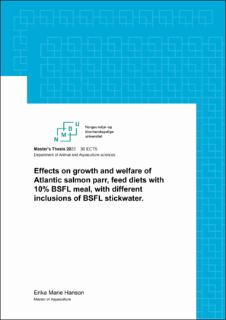Effects on growth and welfare of Atlantic salmon parr, feed diets with 10% BSFL meal, with different inclusions of BSFL stickwater.
Master thesis
Permanent lenke
https://hdl.handle.net/11250/3066278Utgivelsesdato
2022Metadata
Vis full innførselSamlinger
- Master’s theses (BioVit) [348]
Sammendrag
To achieve sustainable growth in aquaculture, it is important to develop feed from more sustainable sources. Black soldier fly larvae meal (BSFL) is a novel ingredient approved by the EU legislation to be used in aquaculture feed. In the process of creating BSFL meal, the BSFL are pressed by a hydraulic press, and becomes a presscake and liquid is removed, the liquid is known as stickwater (SW). SW has a high content of free amino acids and water-soluble proteins, though there is still insufficient knowledge about the properties of SW in diets for salmon. BSFL meal has several challenges, including high levels of chitin and manganese (Mn). BSFL SW has a very low content of Mn and adding BSFL SW in diets for salmon could be beneficial. Would diets with high content of Mn, have a negative effect on fish welfare?
In this study, the BSFL SW was recovered back in the BSFL meal. Four experimental feeds were made, containing 10% BSFL meal with different inclusions of SW, and one control formulated to be similar to commercial diets for Atlantic salmon. There were three tanks per diet, each tank containing 100 Atlantic salmon parr. The feeds were formulated to have similar nutritional value and apparent digestibility coefficient (ADC).
We saw no significant differences between the different dietary treatments, and all fish preformed similarly. BSFL meal contains high amounts of dietary Mn, and the diets with most Mn contained 120mg/kg of this essential trace mineral. There were seen no sign of Mn oversaturation in the fish, nor reduced welfare. Fish feed all experimental diets, preformed as well as those fed control diet. There was no sign of increased growth or welfare from inclusions of BSFL SW, nor any sign of negative impact of high levels of dietary Mn.
